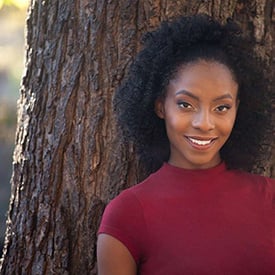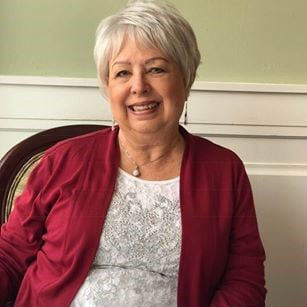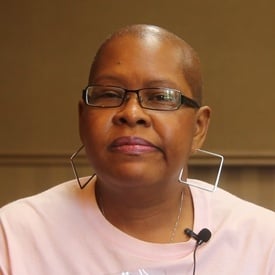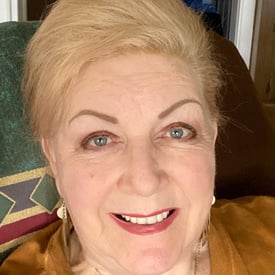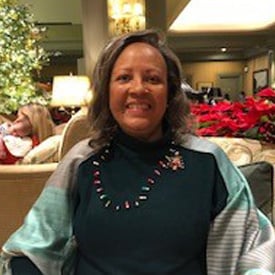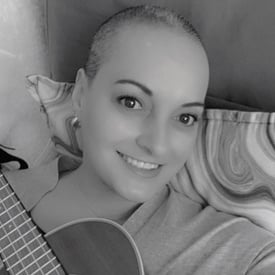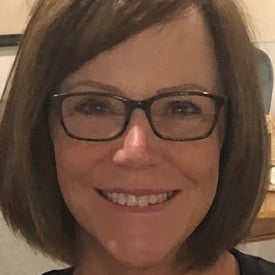Mary B-FFA

The Perfect Storm
Sometime between 2010 and 2011, and maybe even for a few years before, a perfect storm was brewing under my skin unbeknownst to me. External stressors were ramping up, too. My two older sons were starting at two new schools, my husband was taking a job in another city and would be commuting each week, and my father was entering into his end-of- life stage. Physically, I noticed my eyebrows were missing, and I blamed myself for subconsciously pulling on them while I was reading or focusing on something else. Then, my mother, who doesn’t notice many things, commented that my hairline is receding. This began a series of excuses to explain what was happening to me.
I explained my hair away due to my anemia. I was suffering from extremely low ferritin levels and Vitamin D levels, too. After researching anemia and hair loss, I self-prescribed Biotin. My internist couldn’t explain the cause of my receding hairline. I had a newly formed horizontal forehead scar from a Mohs procedure to remove a squamous cell skin cancer which became my hairline landmark. Needless to say, I was a religious user of sunscreen protection. I used sunscreen in any product I put on my skin including moisturizer and makeup. I did, however, think I was seeing a few straggling hairs which convinced me that my hair was growing back. Later, I realized this is a typical pattern of FFA. My internist couldn’t explain the cause of my hair loss or my anemia. I was extremely weak, out of breath when walking up stairs, and felt achy all over, especially in the morning. After a number of tests, a series of iron infusions were prescribed, twice. This involved 5 visits within 2 weeks in the cancer infusion center for an IV push of Iron. It was truly humbling to sit with the patients battling cancer, battling for their lives. I wasn’t like them. At this time, I was 44 years old, an active woman with five children. I play tennis, run, enjoy swimming, and many other outdoor activities. I loved wearing a ponytail, too.
While playing tennis, I typically wore a hat for sun protection. I noticed the hair at my sideburns and above my ears where my sunglass arms hit the sides of my head, was missing. Were the sideburns gone because my sunglasses were rubbing my hair away? Was it from frequent hat wearing? My scalp did itch, but againI blamed it on being hot and wearing hats. I remembered being fatigued that winter and my scalp would itch under my knit caps. The hair on my arms and legs were missing. My internist checked my blood work, thyroid, GI tract, with colonoscopy and endoscopy but he still couldn’t explain my anemia, low vitamin D or hair loss.
Then, during a routine dermatology appointment, in August of 2012, I received a clear skin check. However, my awesome dermatologist Dr. Karen Forsman said, “I am concerned about your hairline, and I know what it is. To be certain, we can biopsy a hair follicle.” I remembered feeling validated! I didn’t want to give up anymore hair, but I needed confirmation and hopefully an answer to my mysterious hair loss. After Frontal Fibrosing Alopecia was diagnosed from the biopsy, Dr. Forsman injected my hairline with steroids and prescribed Doxycycline. I was to return in one month for more steroid injections. In that month, I noticed my scalp stopped itching, the Doxycycline helped with the itch symptom. I hadn’t realized how itchy my scalp had been. It didn’t, however, stop the hair from coming out. I especially noticed the hair loss in the shower when shampooing, I had handfuls of hair in my fingertips and in the tines of my comb.
When I returned the next month for the next set of injections, Dr. Forsman had a new plan. She wanted me to see Dr. Caroline Mann at Washington University School of Medicine who was currently conducting a survey for FFA. Dr. Forsman was more comfortable having Dr. Mann prescribe and monitor a stronger medication to slow the symptoms of FFA, Hydroxycholoquin. Although I was concerned about the variety of possible side effects of Hydroxychloroquine drug therapy, I do believe it is an effective treatment for FFA. It reduced the itching and hair loss.
I don’t remember which doctor prescribed 5% minoxidil, but I do remember taking the script note to the pharmacist and asking where I could find this product. What a surprise it was to me to learn it is the main ingredient in Rogaine. I had no idea. I was to use the 5% strength, the one for men! I was shocked and saddened at the same time. A male hair product to fight baldness was prescribed to me. I initially used the regular minoxidil, but eventually changed to the foam because it was less irritating to my scalp.
All this new information was swirling in my head. The terms “autoimmune,” “hair loss,” “scarring…the hair will not return” were very disconcerting. What did this all mean for me? I was relieved to finally have an answer after two years of searching for an explanation to my hair loss, but I was sad. I was 46, young, active. I like to swim, play tennis, wear ponytails and pull my hair back in a twist with a clip. How could I swim and get out of the water with half of a bald head? How limiting would this condition be for my active lifestyle with my family, children and friends. I searched for information regarding FFA and read Blogs from all over the world. I am not alone in this diagnosis, but I felt alone. I didn’t want to look like the picture of folks I found on the internet. I felt humbled.
Within a few weeks of my initial diagnosis, I did have a healing moment or a moment of perspective during an all school mass where our children attended grade school. I realized that although I may not have hair in future pictures, at least I would still be in the family pictures. This condition is not fatal. My response to this diagnosis was to grow my hair long, a natural reaction when you know you are going to lose something, you hang on tight to it.
I completed the surveys for the Washington University Hair Study. However, I didn’t believe the questionnaire asked enough questions or the right questions to find the common links I may have had with the others participating within the study. I confided in a few close friends. I needed support from my friends and family. It was definitely a blow to my self-esteem. Once, I heard a friend say her mother always told her how important it is to take care of your hair because “it is our best accessory.” How was I supposed to take care of my best accessory with this condition?
The days, months and years following, I did everything suggested to me by Dr. Mann. I followed the drug therapy to take Hydroxychloroquine, which requires frequent lab work because it can affect the liver and bi-yearly eye exams because it can affect my field of vision. I used minoxidil to help lengthen the hair cycle of what hair was left, received steroid injections, and use Clobetasol when my scalp is itchy. I also did my own research and sought the opinion of other dermatologists. Due to my husband’s job, I was able to see a dermatologist with Northwestern University Medical Center in Chicago as part of an executive physical. I also contacted Health Network for any resources that might be available for this condition. Interestingly, even though this was termed “an epidemic in the dermatology world,” there wasn’t anything new to discover; and outside of the dermatology world, no other physicians, from my internist, OBGYN, hematologist, etc., had even heard of this diagnosis.
So, I found myself in a researcher and educator role. My friend was diagnosed with breast cancer. She too would lose her hair, but not her hair cycle. I learned everything about the hair cycle. I found a new hairstylist who was a boost of positivity for me. She was a safe person for me to confide in about my hair dilemma. Shockingly, her first recommendation was “cut it off,” a short pixie cut. She has been a big help to me and my self-esteem. She has helped me with hairstyles to favor what I have left. Overtime, she recognized the same hairline pattern in other women who would sit in her chair, and she was able to recommend to them to see a dermatologist for help.
Every three months at my hair clinic appointment, I hoped that Dr. Mann would have a new bit of information, a piece to the puzzle, a clue to the answers to what caused this: why do I have this and how can I stop this? Dr. Mann said, ‘It will burn out.” I am still waiting for it to burn out.
Overtime, the steroid injections were stopped because it was thinning my skin. Once Dr. Mann said stop using sunscreen because of the hypothesis that the chemicals in sunscreens could have triggered this condition, I stopped all use of all chemical sunscreen products including moisturizers and makeup. Dr. Mann recommended that our entire family stop using sunscreen, especially my daughter. I am spreading the word about the dangers of chemical sunscreens to anyone who will listen.
Then we tried patch testing for metals which didn’t present any informative results. In 2019, Dr. Mann recommended starting a daily dose of Naltrexone. She followed me on this study for a year. I tolerate it okay, and I can’t say I see a big difference, but I’ve had other healthcare professionals say it’s a good drug to use to reduce inflammation of the T-Cells. I also used RevitaBrow to help regrow or lengthen the hair cycle of my brows. I do think it helped a little.
In the Spring of 2021, Dr. Mann suggested we try allergy testing. The latest thinking is there is an allergy trigger which causes FFA. She also prescribed taking Zyrtec once a day. I did this for a couple of weeks, but I discontinued using it. It made me feel drowsy. Dr. Mann referred me to Dr. David Sheinbein, an expert dermatologist and allergist, for skin patch testing of 111 possible allergens. 30 of these are seen as possible triggers for my particular hair loss. These results were very helpful and resulted in my evaluating every product I use on my hair and skin. I thought I was using “clean” products, however, I did not realize these products still had unnecessary chemicals that were taxing my system. It has taken time and lots of patience and inquiries, but I have moved away from any products with chemicals or any ingredients I cannot pronounce. This includes facial and body soaps, lotions, shampoos, conditioners, and all hair coloring products.
In 2014, I started seeing an acupuncturist which stabilized my iron deficiency and other health issues. In 2019, I found my way to another chiropractor to improve my overall body function, eliminate inflammation and to detox my body from any chemicals, etc. to allow my systems to function at their peak performance.
Reactions from my family and friends over this diagnosis have been empathic.
When I first announced my dilemma to my family, my youngest son’s teacher told me he prayed for me during the first grade prayer circle. Obviously, it was taking a toll on him in the form of worry; and I knew I needed to suppress my outward concerns. Now, he tells me my best hair look is my royal blue visor. My husband tells me to get a wig. He is a bottom line guy and is less patient with the entire process. I am not opposed to a hair piece. I just haven’t found one that I like. My hair texture is super fine, and the thought of a wig just sounds hot. Sometimes, I think I might have sensory issues. My daughter says don’t worry about it, but I know she would be fretting if this had happened to her. My son Brendan offered to cut off his hair for me to use as a hair piece. Is that even possible? I asked some of my friends to be honest with me. Let me know when my hairline becomes so bad, that I need to make a significant change in my hair style. Most are afraid to say anything because there is nothing they can say. I find myself looking at everyone’s hairline in any gathering and secretly envying their thick locks. When conversations turn to hair, I quietly listen and hold my tongue. If they only knew how lucky they were. Other times, I see women with what looks like what I have and I so badly want to reach out to them and say, “Hi Friend, I think we have something in common.”
Dr. Mann has also recommended microblading my eyebrows. I did my research and spoke with women that had had it done. I even found the best person in the St. Louis area to do microblading; but at this point, I am content with penciling them in. With my luck, I would have some reaction to the ink.
In the whole scheme of things, this problem is more of a nuisance than a health scare. I just want to go about my business, jump in a pool, not worry on windy days, wear a ponytail, go to a ball game, or dress up for a special event and not be anxious about my balding head or watching people’s eyes wander to my hairline and give me a double take. My time is so precious, I don’t appreciate how much time this condition takes away from my self-confidence, daily duties or free time. The dermatology, eye appointments, and consistent lab work can monopolize my calendar.
Dr. Mann has completed her hair study. I haven’t heard of any significant results. I anticipated from the start the study would learn more from me than I would learn from it. Hopefully, it will help others who might unfortunately have to deal with this epidemic. I will still continue to see Dr. Mann as my dermatologist for my FFA.
My hair follicles are less inflamed. I don’t have redness. The itching is less frequent. My hairline has receded. The skin on my forehead is shiny where my hair used to be. My arm and leg hair are also gone.
Although, I believe this journey started with a perfect storm of stress and health concerns, I’d like to end with the blessings that have helped navigate these waters. I am a deeply spiritual person with a beautiful family. I have the support of dear friends. I have my eyelashes. I don’t need to shave my legs. I am fortunate to have the resources to visit different doctors and try new products. Dr. Mann keeps me updated on the current thinking surrounding this epidemic. SAF provides resources and advocates for this condition.
Overall, I decided to control what I can control. Be as healthy as I can be. Find peace and be nice to myself. Protect my heart. Find joy in simple things. Eat well and get good sleep. In the beginning of this journey, I was very self-conscious about my loss of hair. I would always wear a hat. At 54, I am not as self-conscious as I was at the beginning of this journey. I am comfortable. I am healthy. The storm is receding, but I am ready for the rain to stop.
After mass one day shortly after my diagnosis, I stopped to speak with Fr. Mike Esswein. He is genuinely sincere and solicitous regarding my well-being. I told him about the autoimmune issue presenting itself in hair loss. We both thought of the scripture passage from Luke 12:7, But even the hairs of your head are all counted. Do not fear; you are more valuable than a great number of sparrows. Somehow, this just seems fitting. What really matters is God knows how many hairs I have. I have faith; He must want it this way, even though I’d like to have a few more hairs to count.

